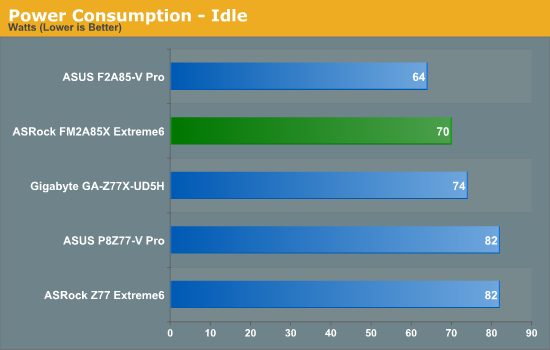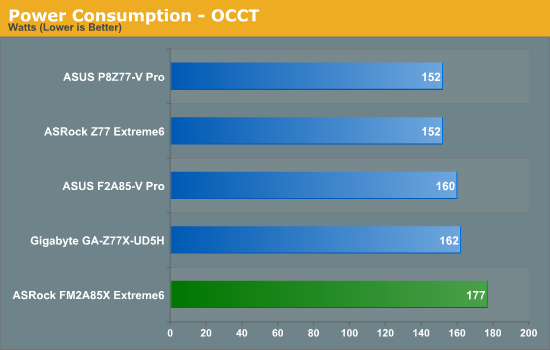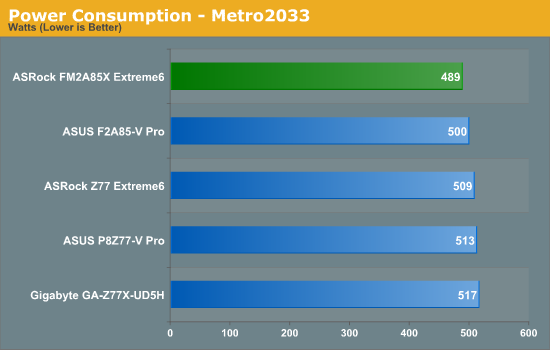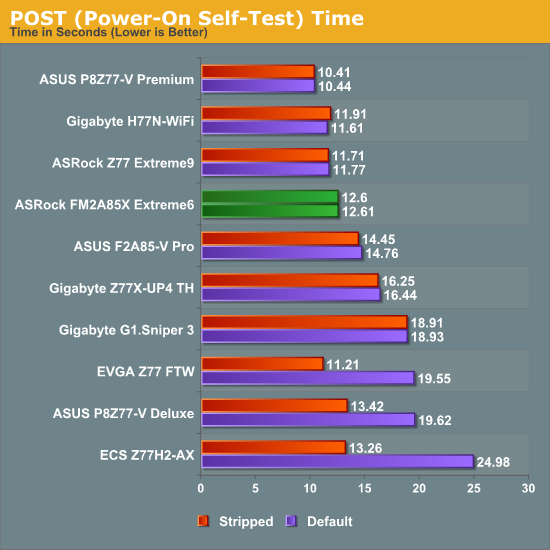ASRock FM2A85X Extreme6 Review
by Ian Cutress on December 3, 2012 12:00 PM EST- Posted in
- Motherboards
- AMD
- ASRock
- Trinity
- FM2
Many thanks to...
We must thank the following companies for kindly donating hardware for our test bed:
OCZ for donating the Power Supply and USB testing SSD
Micron for donating our SATA testing SSD
G.Skill for donating our memory kits
ASUS for donating AMD GPUs and some IO Testing kit
ECS for donating NVIDIA GPUs
Test Setup
| Test Setup | |
| Processor |
AMD Trinity A10-4800K APU 2 Modules, 4 Threads, 3.8 GHz (4.2 GHz Turbo) |
| Motherboards |
ASUS F2A85-V Pro ASRock FM2A85X Extreme6 |
| Cooling |
Intel AIO Liquid Cooler Thermalright TRUE Copper |
| Power Supply |
OCZ 1250W Gold ZX Series Rosewill SilentNight 500W Platinum PSU |
| Memory | G.Skill TridentX 4x4 GB DDR3-2400 9-11-11 Kit |
| Memory Settings | 2133 9-11-11 |
| Video Cards |
ASUS HD7970 3GB ECS GTX 580 1536MB |
| Video Drivers |
Catalyst 12.3 NVIDIA Drivers 296.10 WHQL |
| Hard Drive | Corsair Force GT 60 GB (CSSD-F60GBGT-BK) |
| Optical Drive | LG GH22NS50 |
| Case | Open Test Bed - DimasTech V2.5 Easy |
| Operating System | Windows 7 64-bit |
| SATA Testing | Micron RealSSD C300 256GB |
| USB 2/3 Testing | OCZ Vertex 3 240GB with SATA->USB Adaptor |
Power Consumption
Power consumption was tested on the system as a whole with a wall meter connected to the OCZ 1250W power supply, while in a dual 7970 GPU configuration. This power supply is Gold rated, and as I am in the UK on a 230-240 V supply, leads to ~75% efficiency > 50W, and 90%+ efficiency at 250W, which is suitable for both idle and multi-GPU loading. This method of power reading allows us to compare the power management of the UEFI and the board to supply components with power under load, and includes typical PSU losses due to efficiency. These are the real world values that consumers may expect from a typical system (minus the monitor) using this motherboard.



For comparison, we have adjusted the graphs to include three Z77 motherboards using the i7-3770K, a 77W processor. In terms of power consumption, we can see that Trinity has a lead during idle and during Metro 2033 using two GPUs, however due to the 100W nature of the A10-5800K, Trinity loses out on pure CPU workloads (both in power and performance, especially if the benchmark is primarily FP).
POST Time
Different motherboards have different POST sequences before an operating system is initialized. A lot of this is dependent on the board itself, and POST boot time is determined by the controllers on board (and the sequence of how those extras are organized). As part of our testing, we are now going to look at the POST Boot Time - this is the time from pressing the ON button on the computer to when Windows starts loading. (We discount Windows loading as it is highly variable given Windows specific features.) These results are subject to human error, so please allow +/- 1 second in these results.

Any POST time under 13 seconds is a good result in my book, however the launch of adaptive BIOSes from ASUS and inklings from MSI are starting to put ASRock under pressure. 12.6 seconds to POST is by no means the slowest, but the competition are swarming.










19 Comments
View All Comments
ivica - Monday, December 3, 2012 - link
is there for another reason. There are 3 options to set fast boot on ASrock motherboards, and fastest one disables "entering bios"... so, you can't access bios unless you clear CMOS or through that specific option in AXTU.DanNeely - Monday, December 3, 2012 - link
This seems like an odd feature for a midrange board as opposed to one targeted at the sub-ambient cooling crowd.That aside, I'm curious how it works. Does it just periodically spin the fans up long enough to cycle the air in the case; or is their a humidity sensor that detects when it needs to be cycled.
automaticgiant - Monday, December 3, 2012 - link
I looked at the Realtek website and the feature list for each chip but was unable to determine why one is better other than the power saving. It sounds like "The ASUS gives us another USB 3.0 controller, the ALC892 audio codec and the 8111F NIC - in turn, the ASRock board gives an ASMedia USB 3.0 controller, the better ALC898 audio codec but the 8111E NIC" is saying that the E is crap, but I might be reading into it too much.Merlyn2220 - Monday, December 3, 2012 - link
"Firstly, the amount of components on the top left of the motherboard is insane." This and the following statements are completely wrong. The extra components are likely tuned values of capacitors, resistors and ferrite beads intended to soften clock edges (reducing EMI) and improve high speed stability. As an engineer handling moderate-speed (sub-1GHz) clocks I can say with authority that these components are likely critical to the board's stability and performance. To say that having fewer components helps overclocking is pretty ignorant. /end rant.Rajinder Gill - Tuesday, December 4, 2012 - link
Most of those will be VRM related components. The amount of decoupling that needs to be used depends on the circuit. Generally, better VRM controllers and FETs need fewer output capacitors. The amount of surrounding circuitry for pulling legs of the buck controller down or up varies also - some buck controllers don't need a lot of external hardware to function.cosmotic - Monday, December 3, 2012 - link
In that last product shot, is that on glass or what?Wardrop - Tuesday, December 4, 2012 - link
No. It's the official ASRock product shot. You can tell it's two images layered one on top of the other. They've just added a very rough reflection and shadow effect in Photoshop.abianand - Tuesday, December 4, 2012 - link
What is AMD A10-4800K?- Power Consumption and Post Times page
cyrusfox - Tuesday, December 4, 2012 - link
Well it is obvious he meant the 5800k from the other pages but yes that is a typo in that table there.Garestle - Thursday, March 26, 2020 - link
Check this <a href="http://www.google.com/">google</a> and get everything you need.